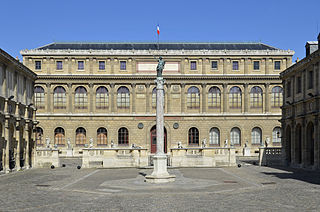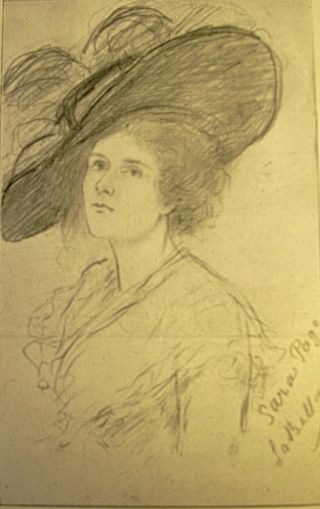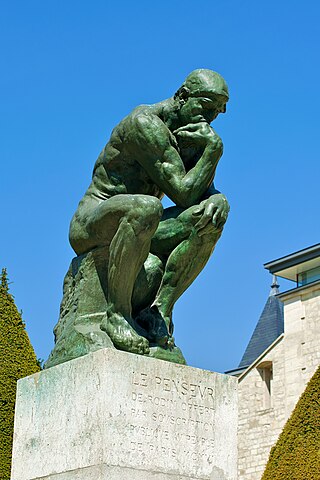Related Research Articles

The Académie royale de peinture et de sculpture was founded in 1648 in Paris, France. It was the premier art institution of France during the latter part of the Ancien Régime until it was abolished in 1793 during the French Revolution. It included most of the important painters and sculptors, maintained almost total control of teaching and exhibitions, and afforded its members preference in royal commissions.

The Beaux-Arts de Paris, formally the École nationale supérieure des beaux-arts, is a French grande école whose primary mission is to provide high-level fine arts education and training. The art school, which is part of the Paris Sciences et Lettres University, is located on two sites: Saint-Germain-des-Prés in Paris, and Saint-Ouen.

The Institut de France is a French learned society, grouping five académies, including the Académie Française. It was established in 1795 at the direction of the National Convention. Located on the Quai de Conti in the 6th arrondissement of Paris, the institute manages approximately 1,000 foundations, as well as museums and châteaux open for visit. It also awards prizes and subsidies, which amounted to a total of over €27 million per year in 2017. Most of these prizes are awarded by the institute on the recommendation of the académies.

The Académie des Beaux-Arts is a French learned society based in Paris. It is one of the five academies of the Institut de France. The current president of the academy (2021) is Alain-Charles Perrot, a French architect.

The Salon, or rarely Paris Salon, beginning in 1667 was the official art exhibition of the Académie des Beaux-Arts in Paris. Between 1748 and 1890 it was arguably the greatest annual or biennial art event in the Western world. At the 1761 Salon, thirty-three painters, nine sculptors, and eleven engravers contributed. From 1881 onward, it was managed by the Société des Artistes Français.

Jean-Baptiste Descamps was a French writer on art and artists, and painter of village scenes. He later founded an academy of art and his son later became a museum curator.

The Académie Royale d'Architecture was a French learned society founded in 1671. It had a leading role in influencing architectural theory and education, not only in France, but throughout Europe and the Americas from the late 17th century to the mid-20th.

The Royal Academy of Fine Arts of Brussels is an art school established in Brussels, Belgium. It was founded in 1711. Starting from modest beginnings in a single room in Brussels' Town Hall, it has since 1876 been operating from a former convent and orphanage in the Rue du Midi/Zuidstraat, which was converted by the architect Victor Jamaer. The school has played an important role in training leading local artists.

Jacques-Albert Senave (1758–1823) was a Flemish painter mainly active in Paris during the late 18th and early 19th centuries. He is known for his genre scenes, history paintings, landscapes, city views, market scenes and portraits.
The Académie de Saint-Luc was the guild of painters and sculptors set up in Paris in 1391, and dissolved in 1776.

Jacques-André-Joseph Aved, also called le Camelot and Avet le Batave, was a French painter of the 18th century and one of the main French Rococo portraitists. He painted among others the Ottoman Empire ambassador to France in 1742, Yirmisekizzade Mehmed Said Efendi.
Henri Testelin (1616–1695) was a French painter and writer on art.

Sara Wells Page (1855–1943) was a British artist, portrait and figurative painter, of the Victorian and Edwardian period. During her lifetime she was widely exhibited at Parisian salons and British galleries, including the Royal Academy of Arts. Three of her paintings are in Wolverhampton Art Gallery.

Marie-Gabrielle Capet was a French Neoclassical painter. She was born in Lyon on 6 September 1761. Capet came from a modest background and her previous background and artistic training is unknown, but in 1781 she became the pupil of the French painter Adélaïde Labille-Guiard in Paris. She excelled as a portrait painter and her works include oil paintings, watercolours, and miniatures.

Gerard van Opstal or Gérard van Opstal, was a Flemish Baroque sculptor mainly active in Paris. He was known for his low-relief friezes with classical mythological themes and his expertise in carving ivory reliefs.

For centuries, Paris has attracted artists from around the world, arriving in the city to educate themselves and to seek inspiration from its artistic resources and galleries. As a result, Paris has received a reputation as the "City of Art". Home to some of the world's most famous museums and galleries, including the Louvre and the Musée d'Orsay, the city today remains home to a thriving community of artists. Paris is recognized globally for its public landmarks and masterpieces of architecture including the Arc de Triomphe and a symbol of France, the Eiffel Tower.

Arnaud Courlet de Vregille is a French painter.

In art, a reception piece is a work submitted by an artist to an academy for approval as part of the requirements for admission to membership.

Jacques-François Delyen was an 18th century French painter, specializing in portraits.

Gisbert Combaz, or Ghisbert Combaz, was a Belgian painter, lithographer, illustrator, poster artist, furniture designer, sculptor, art educator, art historian and lawyer. He originally trained and practised as a lawyer, but gave up his legal career to dedicated himself to art education and art. He was one of the leading Belgian Art Nouveau artists. Despite his talents as a painter, he is now mainly known for his poster designs and postcards as well as his First World War drawings expressing his hatred for the German occupiers. His work showed a strong influence of his in-depth study of Japanese and Chinese art.
References
- Notes
- Sources
- Lane, Harlan (1984). When the Mind Hears: A History of the Deaf. New York: Random House. ISBN 978-0-679-72023-2.
- South Kensington Museum (1891). Catalog of the Science Library in the South Kensington Museum. London: Eyre and Spottiswoode. View at Google Books.
- Sadie, Stanley, editor (1992). The New Grove Dictionary of Opera (4 volumes). London: Macmillan. ISBN 978-1-56159-228-9.
- Sadie, Stanley, editor; John Tyrell; executive editor (2001). The New Grove Dictionary of Music and Musicians , 2nd edition. London: Macmillan. ISBN 978-1-56159-239-5 (hardcover). OCLC 419285866 (eBook).
- Viala, Alain (1985). Naissance de l'écrivain. Paris: Minuit. ISBN 978-2-7073-1025-5.